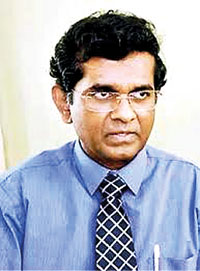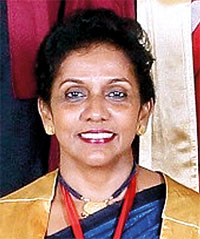News
Urgent call from SLMA – be careful and take all precautions
There was a gradual reduction in cases but after the avurudu season we are seeing an increase in COVID-19 patients not only at the National Institute of Infectious Diseases (NIID) but also other COVID-19 treatment hospitals, said Senior Consultant Physician Dr. Ananda Wijewickrama of the NIID, Angoda.

Dr. Padma Gunaratne
It was a grim picture that was painted at a timely media briefing organized by the Sri Lanka Medical Association (SLMA) on Friday.
The warnings about the looming danger of a third wave which could have serious repercussions on the people came not only from Dr. Wijewickrama but all speakers including SLMA President Dr. Padma Gunaratne.
Dr. Wijewickrama pointed out that in the first and second waves, a majority (80%) of the patients were asymptomatic (without symptoms) or mildly symptomatic. However, now, many patients are symptomatic, have severe symptoms and become seriously ill. In the earlier waves, they mostly saw elderly patients but now they are seeing younger patients.
“We have to be very careful and take the necessary health precautions. If not, the disease will not stay under control, similar to what we see in other countries such as India. If that happens, we will be in a bad state,” he said.
In an interview with the Sunday Times on Thursday, Dr. Wijewickrama said that patients were also coming in late for testing and treatment. One person had had symptoms of cough and fever for eight days before he got himself tested and admitted to hospital. In those eight days, he had still gone to work despite being sick. This will also lead to a spread of the infection.
On Thursday, the NIID’s eight ICU beds were occupied as also 120 of the ward beds.
SLMA President Dr. Padma Gunaratne said that they wished to warn the public of the imminent threat of a third wave of COVID-19 over the next three weeks. Therefore, it was essential for everyone to take all possible precautions.

Dr. Ananda Wijewickrama
“There is a rapid increase in the number of positive cases, as well as the number of patients requiring hospital admissions, oxygen and treatment in ICUs. Doctors have also observed an increase in the number of positive reports at the laboratories. The numbers detected through random testing in the Colombo Municipal Council area have also increased,” she pointed out.
Dr. Gunaratne said that doctors have observed patients presenting with atypical symptoms and rapid deterioration, leading to serious clinical conditions. Possible rapid transmission is also suspected. Presentation of younger patients with more serious symptoms has also been noted, while doctors at the Lady Ridgeway Hospital (LRH) for Children have also observed the rapidly increasing number of positive cases among children.
“Therefore, it is important for everyone to understand the potential disastrous consequences of a third wave, especially with a possible new virus variant,” she said, adding that if there is a flood of COVID-19 cases leading to a greater number of seriously ill patients, there could be the possibility of exceeding the capacity of hospitals. This is likely to lead to more deaths.
It is essential to wear face-masks correctly, maintain a metre or more distance and wash hands frequently, while avoiding crowded places, she added.
Echoing these concerns, the Colombo Municipal Council’s Chief Medical Officer Dr. Ruwan Wijayamuni looked back at the first and second waves.
“We were able to reduce the number of cases in the first wave within 3-4 weeks. In the second wave which started mid-October last year with the highest number of cases being reported in November and December (due to New Year and Christmas celebrations), the reduction came in February this year with only 2-3 cases reported per day consistently for 6 weeks. This was until the avurudu season,” he said.

Dr. Ruwan Wijayamuni
Dr. Wijayamuni gives the chilling data –
- While only 26 cases were reported the week prior to avurudu, within a week, this number has doubled.
- A cluster of 84 infections mushroomed from a bank.
- Random testing of 73 people at a fisheries harbour on Thursday had detected 8 positives giving an infection rate of 10%.
- Before avurudu the positivity rate was less than 1%, then on April 15 and 16, it increased to 2% and now testing at the fisheries harbour has given a figure of 10%.
When asked whether the rise in positives is being detected due to more testing, Dr. Wijayamuni said that it was not linked. “We increased our RT-PCR testing and Rapid Antigen Testing (RAT) by seven-fold from November onwards until February end. With the seven-fold increase, we expected a spike in cases, but it did not happen like that.”
Pointing out that they reduced testing because there was no necessity to do unnecessary screening, he however stressed that there is a reluctance on the part of the people to get tested which was a problem.
“In controlling the third wave, this could become a major hindrance as those who are infected would also be spreading the disease. We need them to cooperate,” he said, adding that people should stay at home and not venture out on unnecessary trips.

Dr. Kanthi Nanayakkara
Dr. Wijayamuni warned: “We need another two incubation periods (28 days) to step away from the brink of the third wave.”
Meanwhile, Dr. Kanthi Nanayakkara of the Medical Research Institute (MRI) gave more disturbing data on positivity among samples received by the COVID Laboratory 3 of the MRI's Department of Rabies & QC (Quality Control), while pointing out that the percentage of cases in the first wave was very low and in the second was – October: 18%, November: 9%, December: 5%, and January & February: 6%.
“In March, some days were without any COVID-19 positive reports. The situation was fine. If we take the four weeks in March, only 1% was positive, then closer to avurudu it was 2% due to shopping crowds,” she said.
Positives in April:
- April 1, 2 & 3 – up to 3%
- April 7, 8 & 9 – 4%
- April 10 – 6%
- April 19 – 18%
- April 20 – 12%
- April 22 – 8%
Dr. Nanayakkara said that it suggests that a third wave can be expected and “we are just a few stages away. We should take all the necessary safety precautions and not let the country go into a third wave. We can see the situation in India and Brazil and it is our duty not to let it happen in Sri Lanka”.


